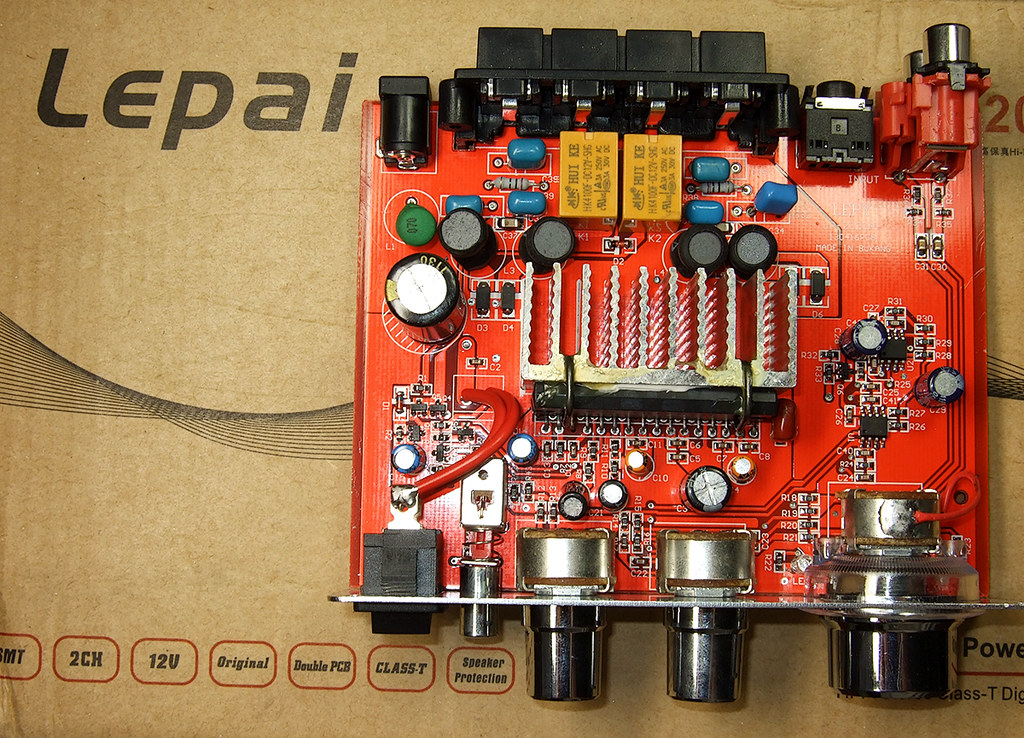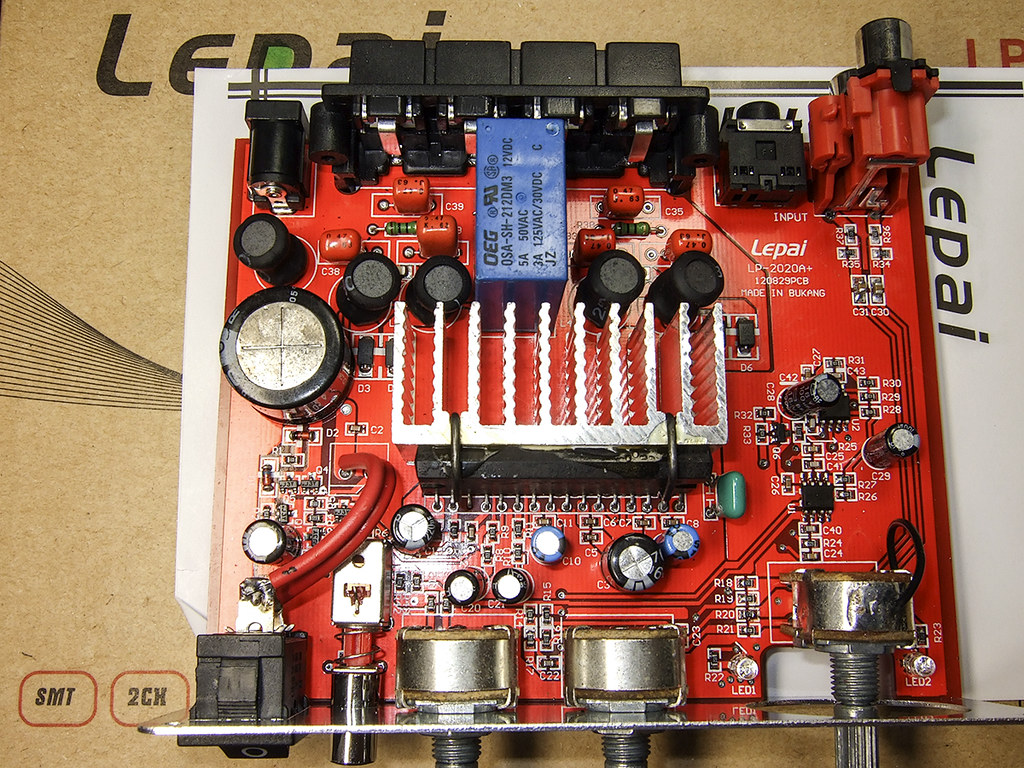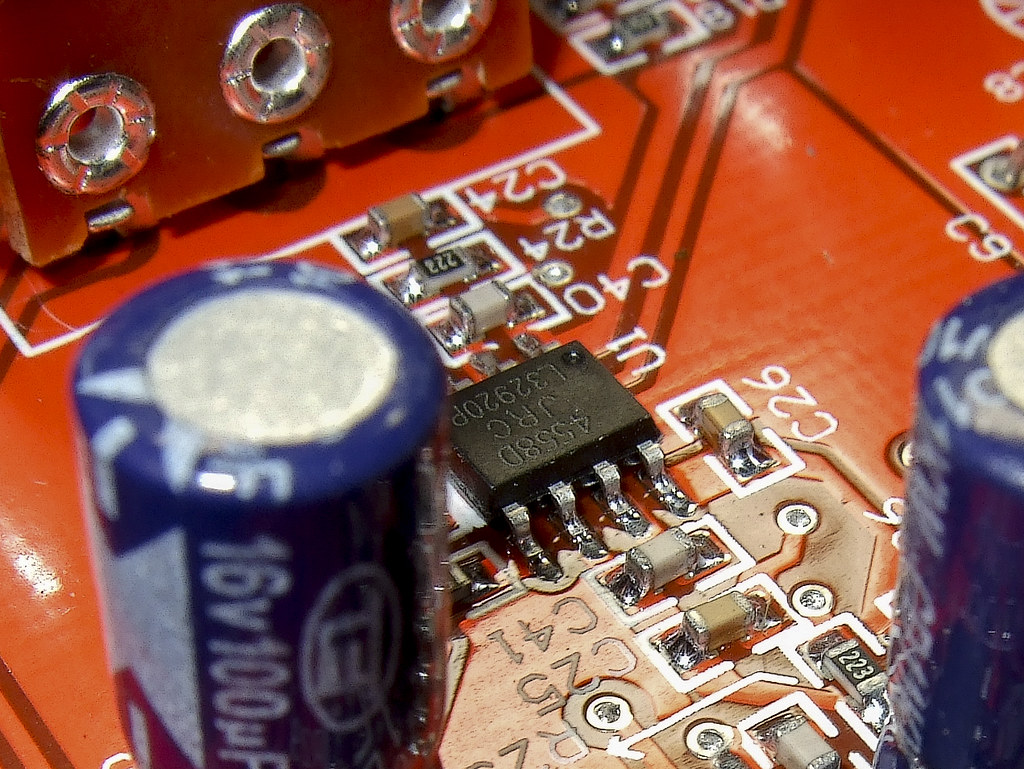A few Ebay sellers include a 12V 5A universal AC power adapter together with the amp. Buy from them.
An externally hosted image should be here but it was not working when we last tested it.
To those of you who aren't aware, Lepai is actually a manufacturing company that purchase huge quantity of closeout electronic components from big firms that gone bust (such as in the fate of Tripath) at very, very low prices. The company also takes in rejected goods from well-known electronic manufacturers (such as Omron, Nichicon and Matsushita, where they usually follow very tight tolerances). In short, it is a rag-and-bone company.
The company assembles these components and makes it into something useful but at a low cost. That is why the Lepai is cheap in China. But when their goods are exported to North America and Europe, prices increase by 5 to 10 times.
Then explain why all lepai amps seem to only use the cheapest crap components you can find such as noname capacitors and weird obscure manufacturer names on others.
Then explain why all lepai amps seem to only use the cheapest crap components you can find such as noname capacitors and weird obscure manufacturer names on others.
Which version of Lepai are you referring to? By the way, I don't work for them or their distributors. The latest version 3, revision B (in red PCB) uses better parts. Like I said earlier, Lepai buys closed-out or rejected components from OEM factories. Therefore, you don't see two batches of Lepai with the same components.
"No name and weird obscure manufacturer" only applies to outside China. There are a lot of products from "No name and weird obscure manufacturers" in China that is actually better than many western brands, one such example is Double Deer batteries ("双鹿电池" - a Chinese domestic battery brand) . These batteries are low price, leakproof and very long-lasting... In fact, Double Deer alkaline batteries last longer than branded ones such as Energizer or Duracell. That's why we buy them in boxes and distribute to the rural villagers. So, "No Name and weird obscure manufacturer" does not always equate to no good.
Last edited:
Tekko:
My friend, you have got to try to be more positive in life. Complain less and be mindful. Nobody is forcing you to buy or use something you dislike.
You are a senior member of this forum, be like one. Otherwise new members, like myself, may not feel welcome. Let's make this forum a pleasant place for everybody.
My friend, you have got to try to be more positive in life. Complain less and be mindful. Nobody is forcing you to buy or use something you dislike.
You are a senior member of this forum, be like one. Otherwise new members, like myself, may not feel welcome. Let's make this forum a pleasant place for everybody.
Last edited:
I sort of wondered why you are such a caustic Lepai knocker until I read another thread today where you admitted to helping the promotion of another amplifier.Then explain why all lepai amps seem to only use the cheapest crap components you can find such as noname capacitors and weird obscure manufacturer names on others.
I hope you are getting paid for being a ...........? 😀
Well pre filter feedback is the result of a developer of class d amps getting everything wrong, and the lepai amps have pretty much the worst build quality i've ever seen and garbage components.
Quality capacitors are made by Nichicon, Nippon Chemicon, Rubycon and such, not some onehunglow noname chinabrand like capxon and such, these obscure cheapo chinabrand are what make stuff fail.
Quality capacitors are made by Nichicon, Nippon Chemicon, Rubycon and such, not some onehunglow noname chinabrand like capxon and such, these obscure cheapo chinabrand are what make stuff fail.
I sort of wondered why you are such a caustic Lepai knocker until I read another thread today where you admitted to helping the promotion of another amplifier.
Thanks radiosmuck for the CSI. That explains EVERYTHING!

Anyway, to those folks who are STILL interested to explore Lepai amps, their latest version 3, Revision B in red PCB (made on 16 April 2013) uses:

----------
Every batch of Lepai I received is different. This is the previous set of version 3, Revision B (made on 29 August 2012)

[photos: KopiOkaya]
- one 2200uf 16V Nippon Chemicon power capacitor,
- a few Chinese capacitors such as Hoe Kee, 和平 (OEM manufacturer for Rubycon and Panasonic), HongX, KHC, T3 and Hi-Q,
- two Hui Ke relays (OEM manufacturer for Omron),
- four UL-rated 10uH SA inductors,
- two JRC 4665 opamps

----------
Every batch of Lepai I received is different. This is the previous set of version 3, Revision B (made on 29 August 2012)

[photos: KopiOkaya]
Last edited:
I always take a look at inside and test the Lepai amps before sending them to the villages. This is to ensure unit safety and minimizes hassle for the volunteers (they don't carry tools and soldering iron).
I have mentioned above, every batch of Lepai is different. Every batch has a "surprise" inside... I have noticed an improve in quality and build nonetheless. I used to receive a couple of them with leaking capacitors. I did a quick repair before sending them to the volunteers.
I encountered volume problem with the last batch of Lepai I received. Thanks to fellow forum member Switter, he helped solve it. 🙂
Bottomline is, for about US$15 (with 12V 5A power adapter included), you have a decent quality amp to explore and make new friends on this forum at the same time.
I have mentioned above, every batch of Lepai is different. Every batch has a "surprise" inside... I have noticed an improve in quality and build nonetheless. I used to receive a couple of them with leaking capacitors. I did a quick repair before sending them to the volunteers.
I encountered volume problem with the last batch of Lepai I received. Thanks to fellow forum member Switter, he helped solve it. 🙂
Bottomline is, for about US$15 (with 12V 5A power adapter included), you have a decent quality amp to explore and make new friends on this forum at the same time.
Last edited:
@KopiOkaya - this is much improved over earlier versions (was blue board and really crappy, crappy soldering job) - but under $20.00 you simply cannot go wrong...
@Tekko at this price what do you expect Sir?
I have Lepai amps (old crummy ones) running for years without an issue - it is a great non-audiophile little amp that has a decent resolution and extension - there is nothing better on the market for less. ( PRICE OF three beers Fellas ) Cheers...🙂
@Tekko at this price what do you expect Sir?
I have Lepai amps (old crummy ones) running for years without an issue - it is a great non-audiophile little amp that has a decent resolution and extension - there is nothing better on the market for less. ( PRICE OF three beers Fellas ) Cheers...🙂
Thank you... Yes, for under US$20, there is nothing much we can pick on. Like I said before, be satisfied with it and we are happier. 🙂@KopiOkaya - this is much improved over earlier versions (was blue board and really crappy, crappy soldering job) - but under $20.00 you simply cannot go wrong...
Last edited:
My blue board LP2020A+ used JRC 4558 op amps. Swapping them out was my only mod (not including the power supply), so it's interesting that Lepai changed their BOM (or maybe the op amps are also chosen from that "what's available today" list).[*] two JRC 4665 opamps
----------
Every batch of Lepai I received is different. This is the previous set of version 3, Revision B (made on 29 August 2012)
My blue board LP2020A+ used JRC 4558 op amps. Swapping them out was my only mod...
The new Lepai uses surface mounted JRC 4665 opamps. It is a bit tricky to work with SMDs. Without proper soldering tools, I may damage the PCB.
My blue board LP2020A+ used JRC 4558 op amps...
My bad...
 You are right! Lepai uses two JRC 4558D opamps.
You are right! Lepai uses two JRC 4558D opamps.
[photo: KopiOkaya]
I encountered volume problem with the last batch of Lepai I received. Thanks to fellow forum member Switter, he helped solve it. 🙂
You're welcome.
Glad to have been useful 😉
You're welcome.
Glad to have been useful 😉
Thanks, Switters. 😉
That's why such forum exists. To help and support others.
I really wish this lepai garbage could be taken off the market.
The capacitors are crap, the pots are trash and the board layout looks like something a 5 year old has drawn up, its clear that whoever designed the Lepai LP2020 has no clue about board layouting at frequencies above 20kHz.
The layout looks like what is used on low cost gainclone style class ab chipamps.
The capacitors are crap, the pots are trash and the board layout looks like something a 5 year old has drawn up, its clear that whoever designed the Lepai LP2020 has no clue about board layouting at frequencies above 20kHz.
The layout looks like what is used on low cost gainclone style class ab chipamps.
Oh, dear me... Somebody here can hear frequencies above 20Khz. He must be either superhuman or a bat. 😀
Frankly, the only thing about amps that bothers me is low frequency hum. And Lepai has virtually none of it after testing more than 10 sets (mostly not mine).
Frankly, the only thing about amps that bothers me is low frequency hum. And Lepai has virtually none of it after testing more than 10 sets (mostly not mine).
Last edited:
I don't know about the rest of you, I had built several kit amps in the past - from Marantz 9 to Cary 300B. My greatest challenge has always been eliminating, or at least, reducing hums. I hadn't been very successful so far. Either I did something wrong or I was ignorant, but that was history.
Naturally, the first time I hooked-up the Lepai to a pair of speakers was to hear for hum. Without connecting to a music source, I dialed the volume knob to maximum and tried very hard to detect hum (my ears were inches away from the woofer). There was none! Like most people, I was skeptical initially but was convinced this US$10 amp can be good.
Nowadays I don't bother what people say about this "cheapo" amp. One thing for sure, it definitely sounds cleaner and quieter than those gigantic vintage amps I had built.
Naturally, the first time I hooked-up the Lepai to a pair of speakers was to hear for hum. Without connecting to a music source, I dialed the volume knob to maximum and tried very hard to detect hum (my ears were inches away from the woofer). There was none! Like most people, I was skeptical initially but was convinced this US$10 amp can be good.
Nowadays I don't bother what people say about this "cheapo" amp. One thing for sure, it definitely sounds cleaner and quieter than those gigantic vintage amps I had built.
Last edited:
I think Tekko gets a woody every time he puts down Lepai. That's the only conclusion I can arrive at since he keeps doing it over and over.
We get your point, Tekko. You have made it many times over. Could you please drop it? 😀
We get your point, Tekko. You have made it many times over. Could you please drop it? 😀
- Status
- Not open for further replies.
- Home
- Amplifiers
- Class D
- Lepai T-Amp with TA2020